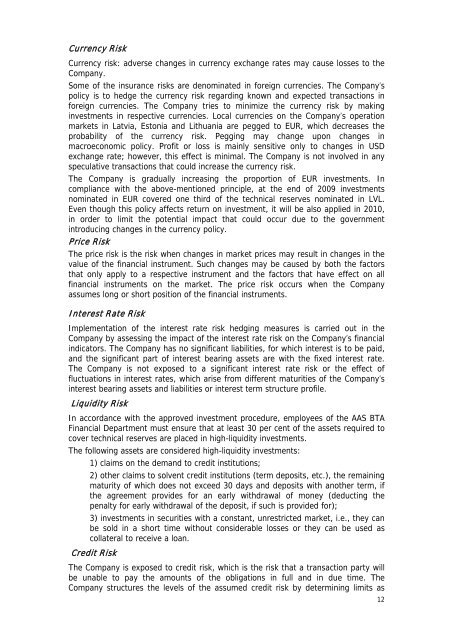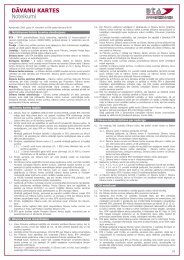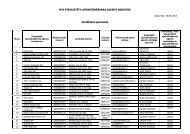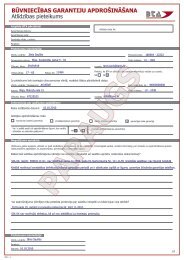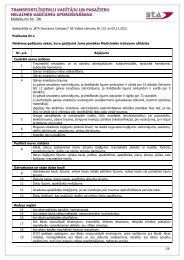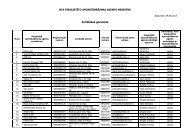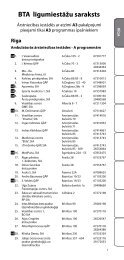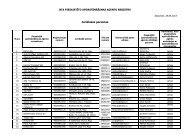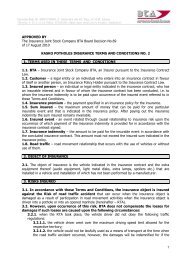BTA Insurance Joint Stock Company Public Quarterly Report 4 ...
BTA Insurance Joint Stock Company Public Quarterly Report 4 ...
BTA Insurance Joint Stock Company Public Quarterly Report 4 ...
Create successful ePaper yourself
Turn your PDF publications into a flip-book with our unique Google optimized e-Paper software.
Currency Risk<br />
Currency risk: adverse changes in currency exchange rates may cause losses to the<br />
<strong>Company</strong>.<br />
Some of the insurance risks are denominated in foreign currencies. The <strong>Company</strong>’s<br />
policy is to hedge the currency risk regarding known and expected transactions in<br />
foreign currencies. The <strong>Company</strong> tries to minimize the currency risk by making<br />
investments in respective currencies. Local currencies on the <strong>Company</strong>’s operation<br />
markets in Latvia, Estonia and Lithuania are pegged to EUR, which decreases the<br />
probability of the currency risk. Pegging may change upon changes in<br />
macroeconomic policy. Profit or loss is mainly sensitive only to changes in USD<br />
exchange rate; however, this effect is minimal. The <strong>Company</strong> is not involved in any<br />
speculative transactions that could increase the currency risk.<br />
The <strong>Company</strong> is gradually increasing the proportion of EUR investments. In<br />
compliance with the above-mentioned principle, at the end of 2009 investments<br />
nominated in EUR covered one third of the technical reserves nominated in LVL.<br />
Even though this policy affects return on investment, it will be also applied in 2010,<br />
in order to limit the potential impact that could occur due to the government<br />
introducing changes in the currency policy.<br />
Price Risk<br />
The price risk is the risk when changes in market prices may result in changes in the<br />
value of the financial instrument. Such changes may be caused by both the factors<br />
that only apply to a respective instrument and the factors that have effect on all<br />
financial instruments on the market. The price risk occurs when the <strong>Company</strong><br />
assumes long or short position of the financial instruments.<br />
Interest Rate Risk<br />
Implementation of the interest rate risk hedging measures is carried out in the<br />
<strong>Company</strong> by assessing the impact of the interest rate risk on the <strong>Company</strong>’s financial<br />
indicators. The <strong>Company</strong> has no significant liabilities, for which interest is to be paid,<br />
and the significant part of interest bearing assets are with the fixed interest rate.<br />
The <strong>Company</strong> is not exposed to a significant interest rate risk or the effect of<br />
fluctuations in interest rates, which arise from different maturities of the <strong>Company</strong>’s<br />
interest bearing assets and liabilities or interest term structure profile.<br />
Liquidity Risk<br />
In accordance with the approved investment procedure, employees of the AAS <strong>BTA</strong><br />
Financial Department must ensure that at least 30 per cent of the assets required to<br />
cover technical reserves are placed in high-liquidity investments.<br />
The following assets are considered high-liquidity investments:<br />
1) claims on the demand to credit institutions;<br />
2) other claims to solvent credit institutions (term deposits, etc.), the remaining<br />
maturity of which does not exceed 30 days and deposits with another term, if<br />
the agreement provides for an early withdrawal of money (deducting the<br />
penalty for early withdrawal of the deposit, if such is provided for);<br />
3) investments in securities with a constant, unrestricted market, i.e., they can<br />
be sold in a short time without considerable losses or they can be used as<br />
collateral to receive a loan.<br />
Credit Risk<br />
The <strong>Company</strong> is exposed to credit risk, which is the risk that a transaction party will<br />
be unable to pay the amounts of the obligations in full and in due time. The<br />
<strong>Company</strong> structures the levels of the assumed credit risk by determining limits as<br />
12


